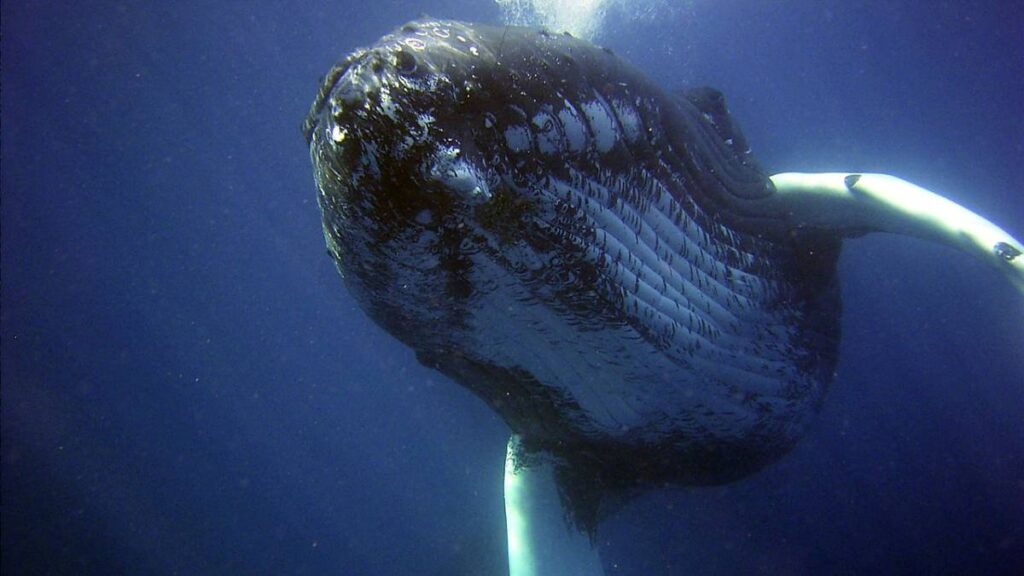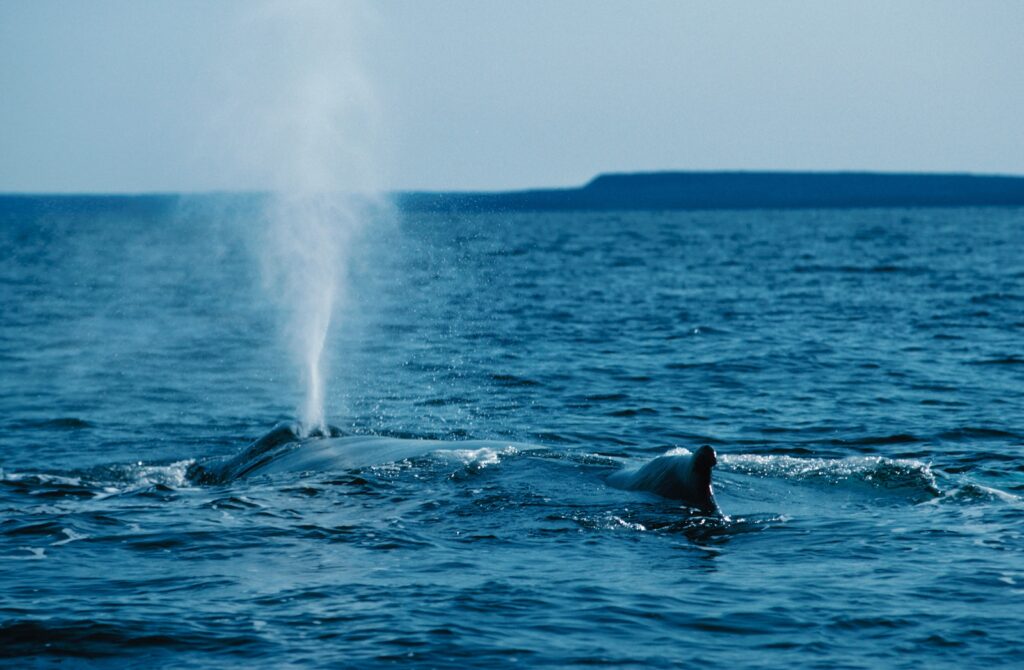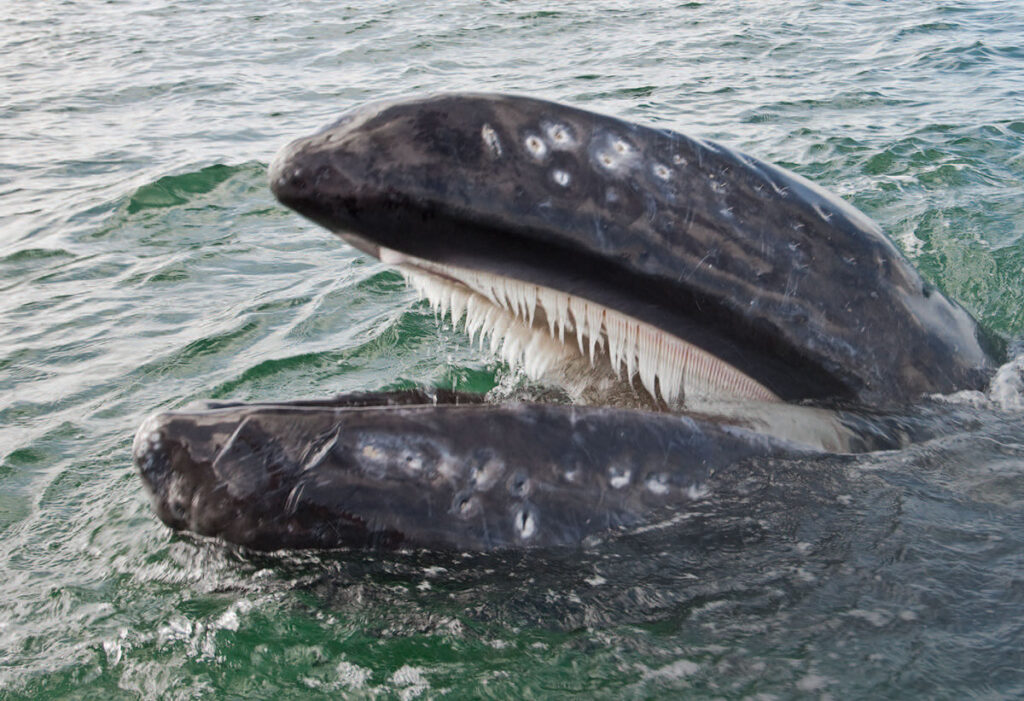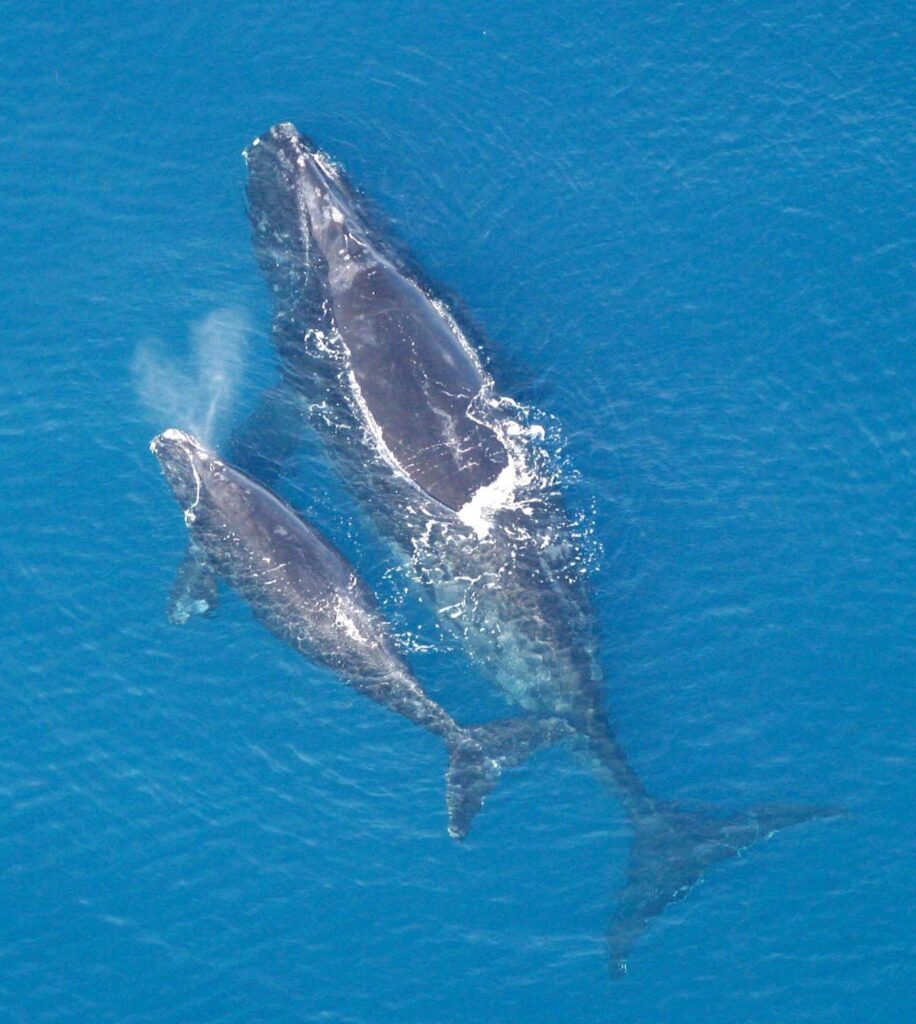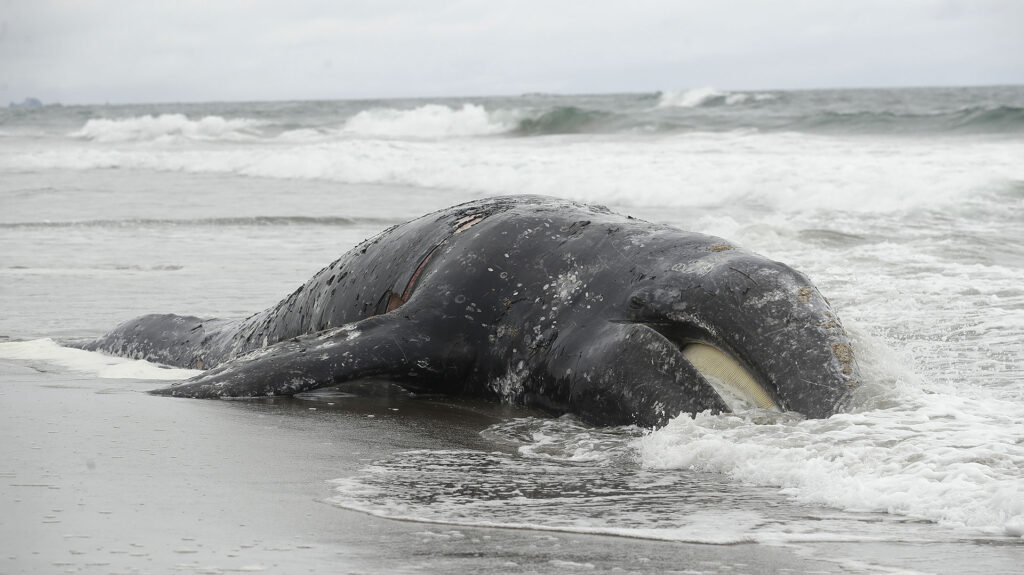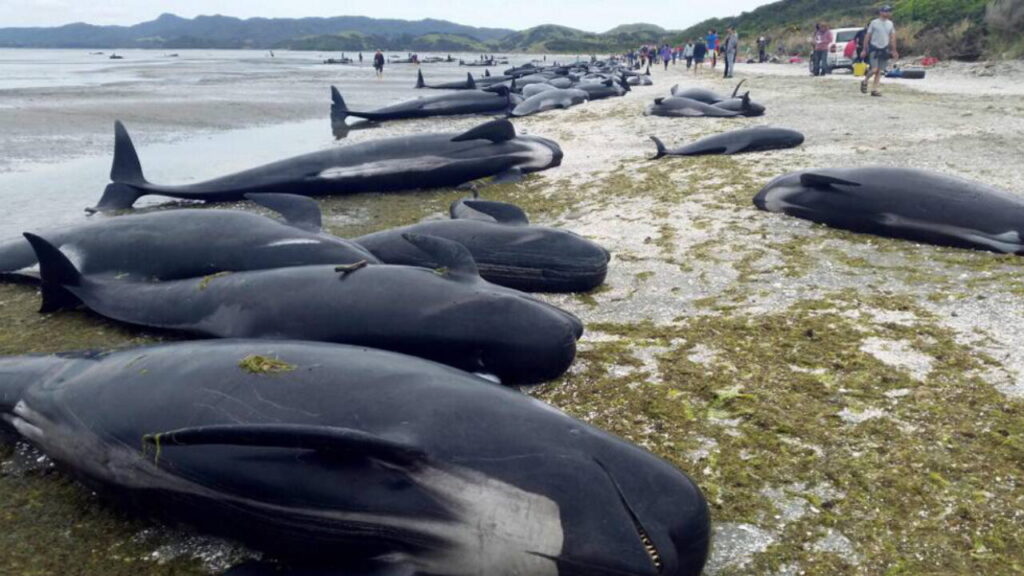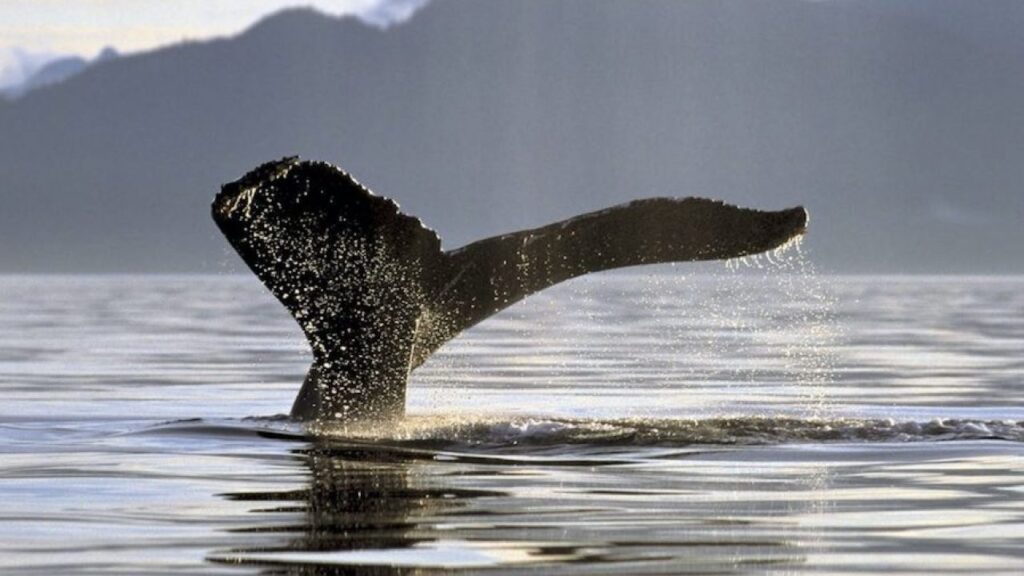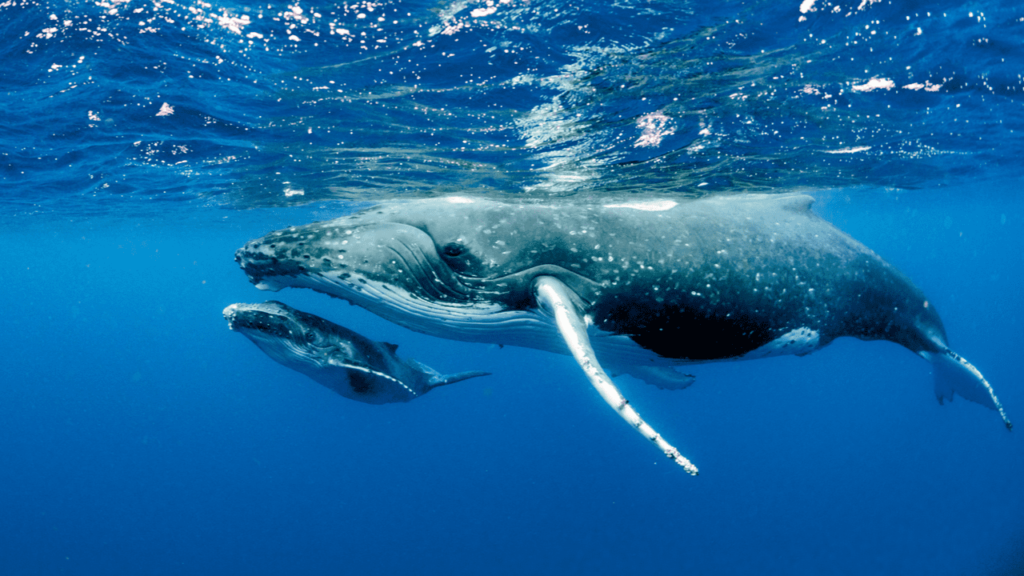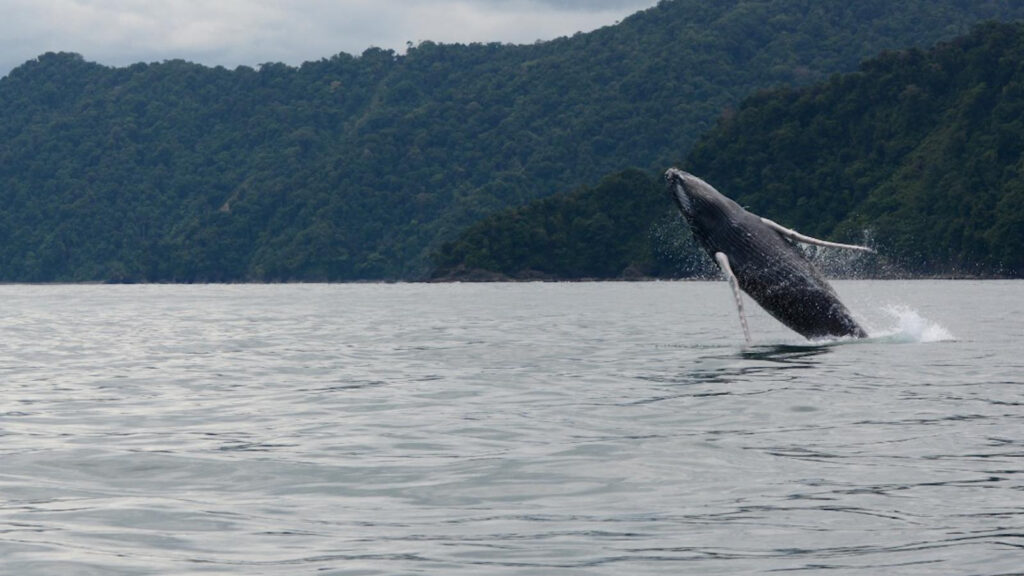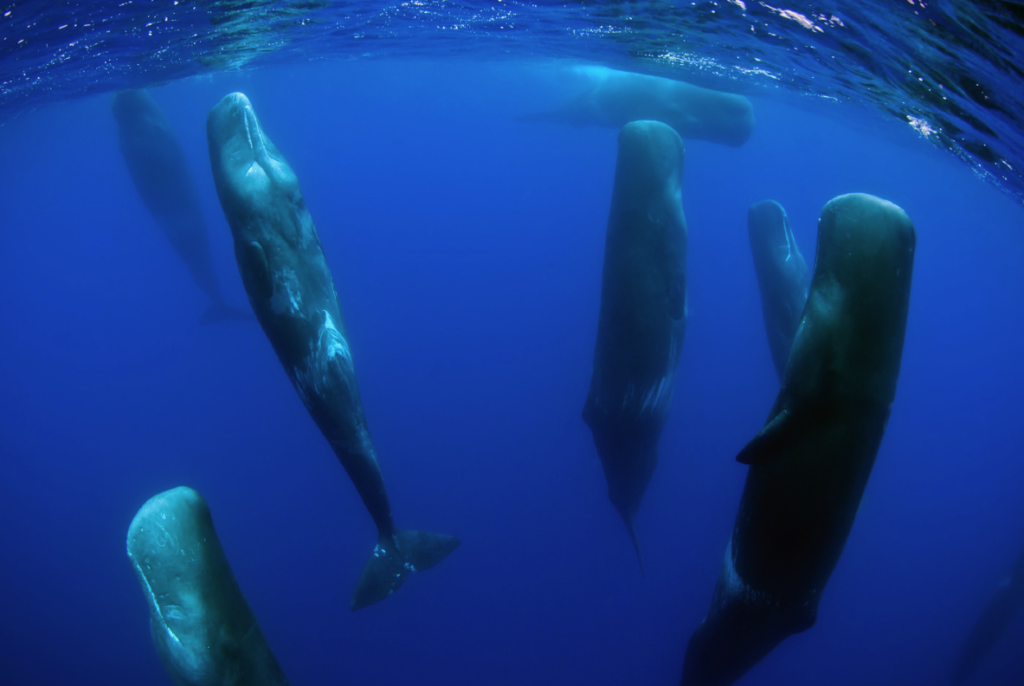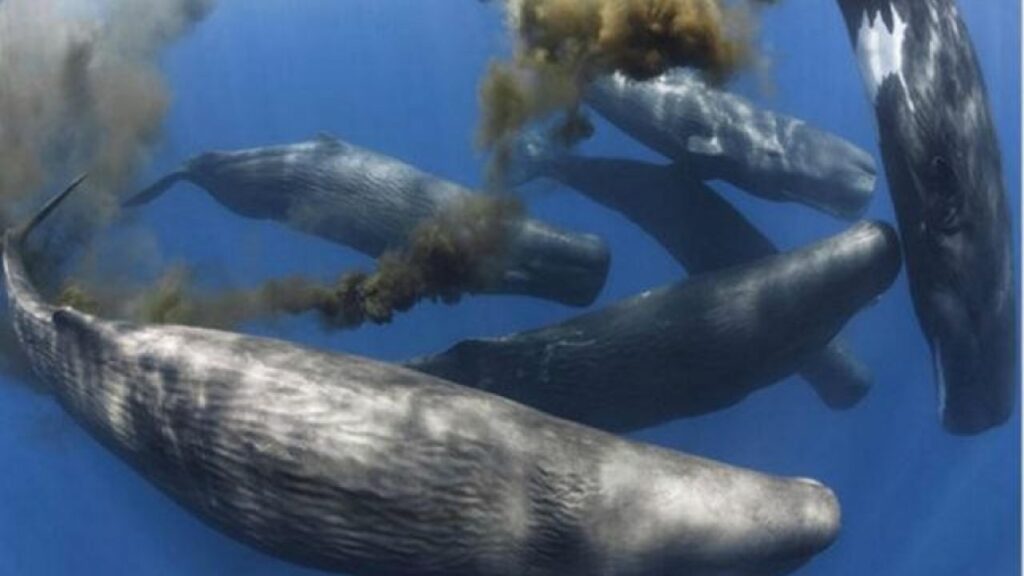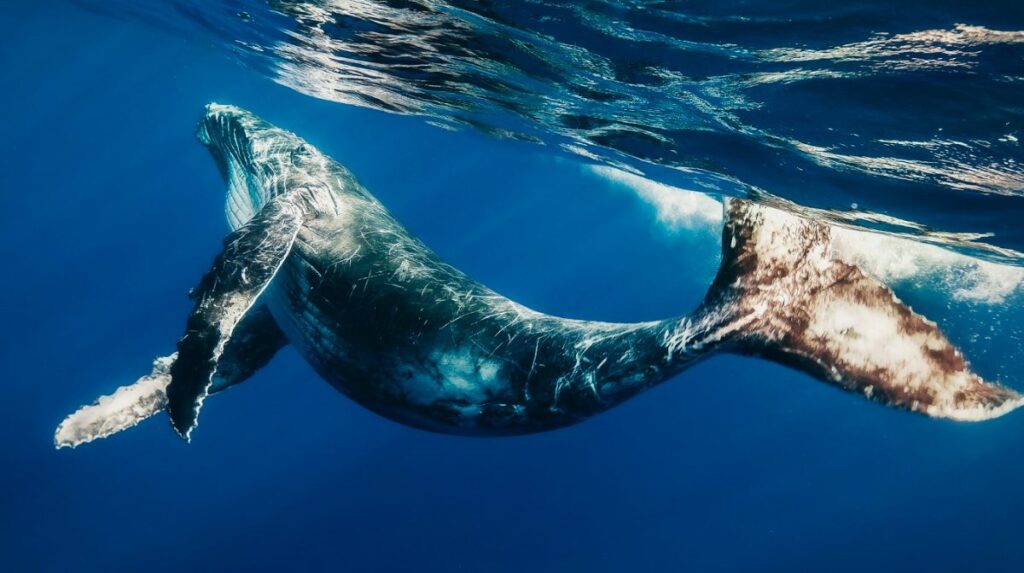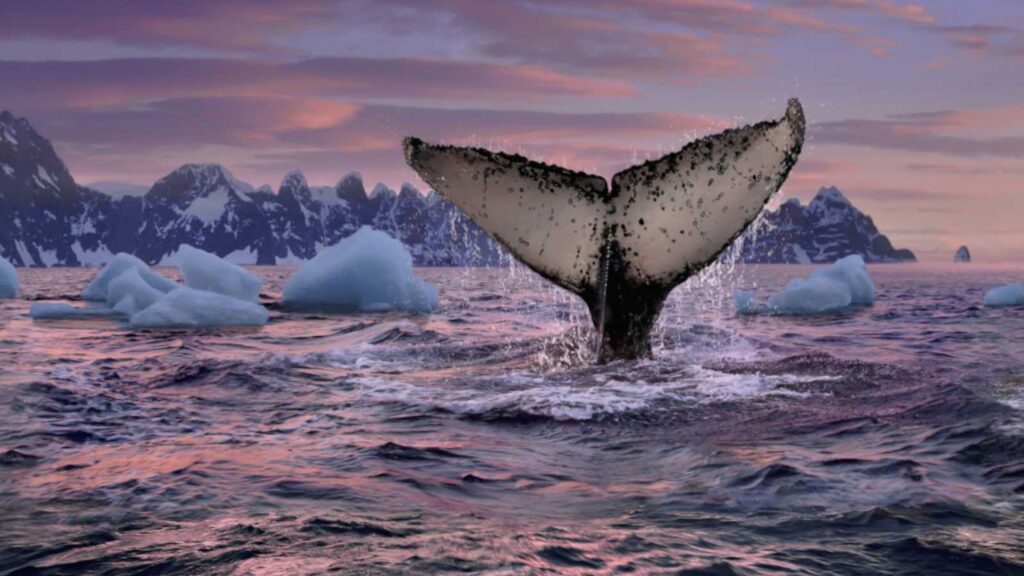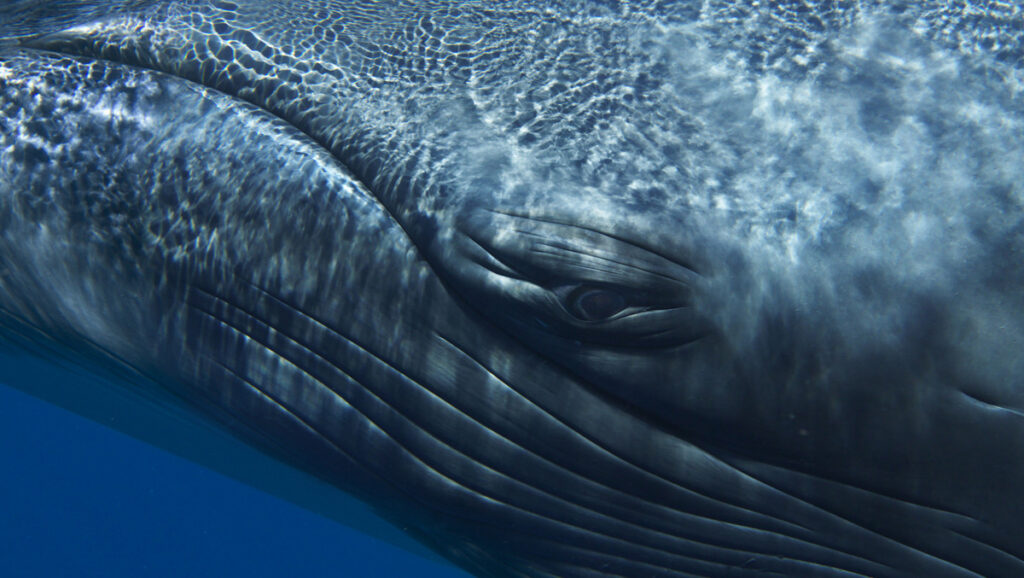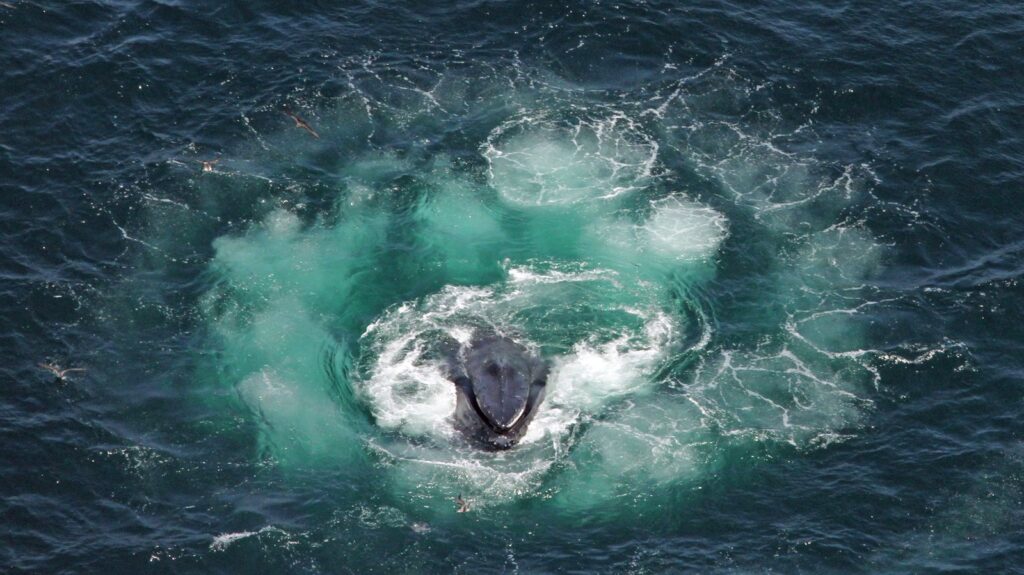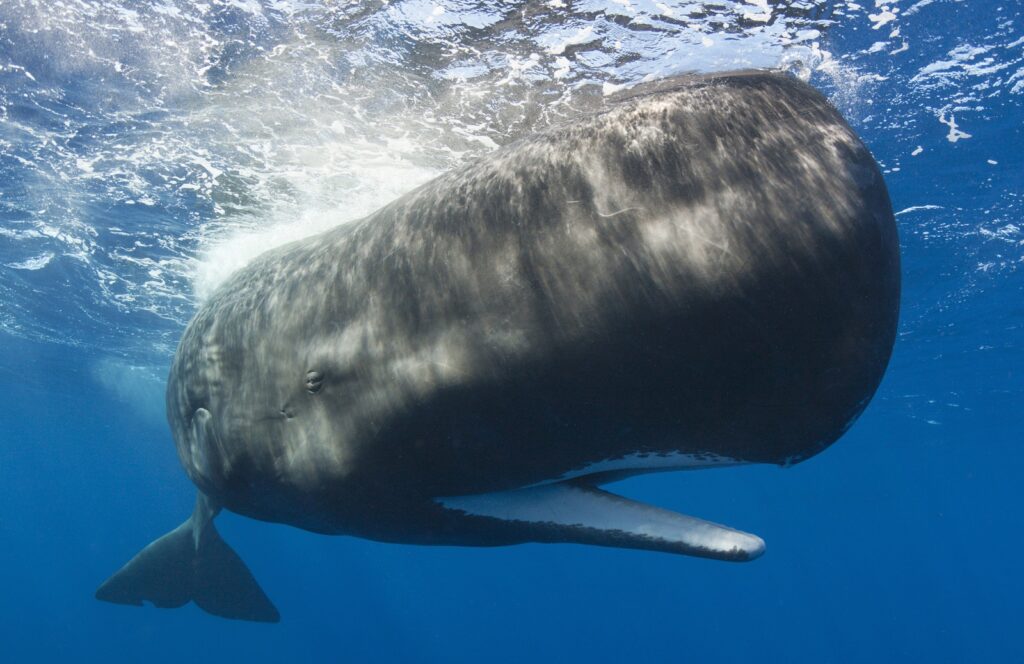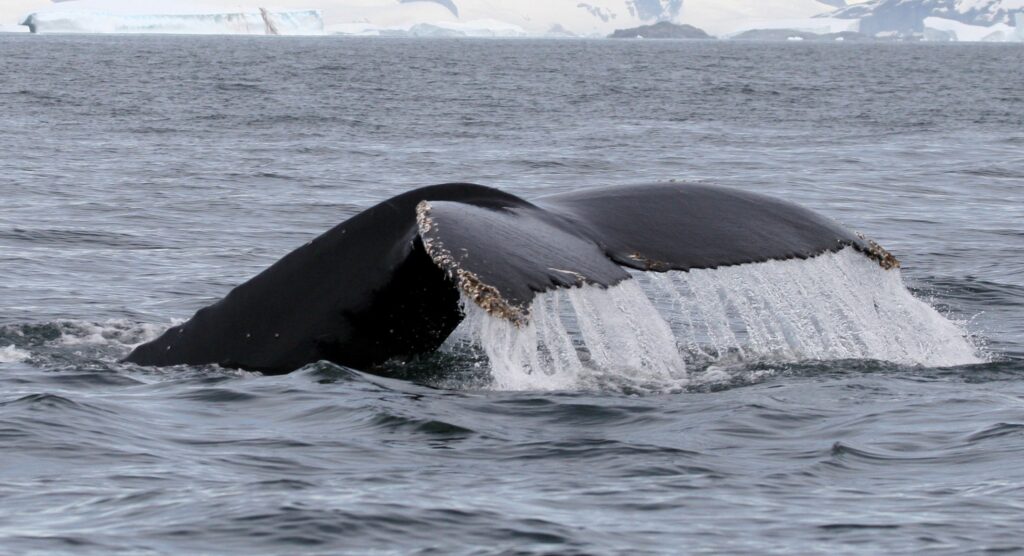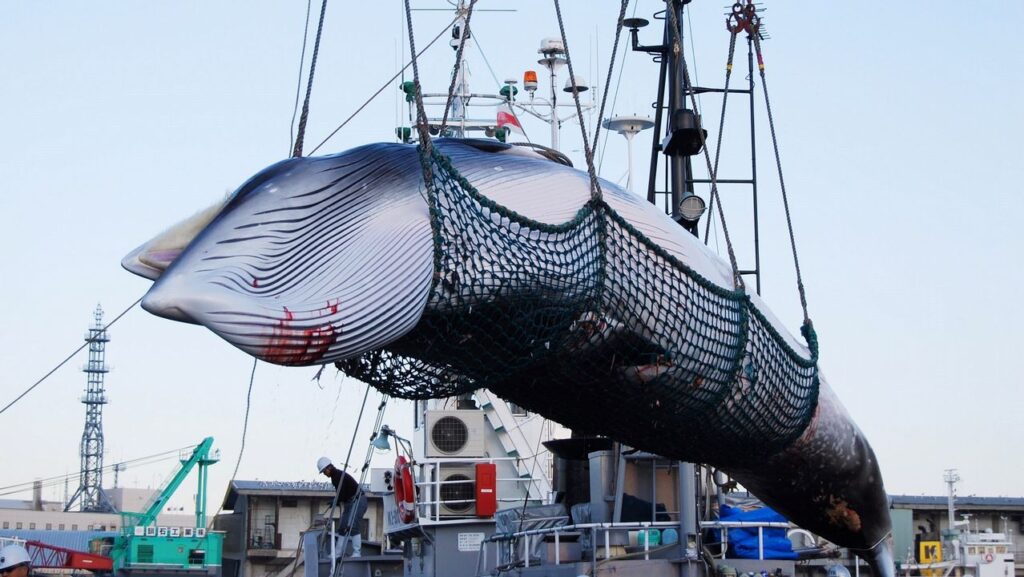Whales are mammals fully adapted to aquatic life and are considered to be the largest animals on the planet. They are descended from land creatures that returned to the sea after living millions of years on land. To maintain their colossal frame they must feed in large numbers on some of the ocean's tiniest organisms. Find out below about the Types of Whales.

The Types of Whales
It is still a wonderful sight to contemplate for the first time a group of whales in freedom. In addition to being amazed, one is seduced when observing how these enormous mammals move with such majesty through the oceans. These are moments in which we realize our insignificance and how small this world can be for such colossal animals that are considered to be the largest on the planet.
Etymology
The word whale, from the Latin ballaena, familiar with the Greek phalaina, has an uncertain etymological origin. Its meaning would be unknown if it came from some ancient Mediterranean language, or if it were of Indo-European origin, perhaps Illyrian, perhaps it would refer to the cylindrical or bulky shape typical of this family. These cetaceans were also known as Cetus, the great fish, the Leviathan or the sea monster. The baleen, as the keratinous sheets are called that enable them to filter food from the water, are also called whales, and in English they are called baleens.
Taxonomic Description
The whale is a mammal of the cetacean family, in which dolphins and porpoises are also grouped. The word "whale" is a very vague term that can lead to confusion, since, for example, orcas, which are called killer whales, are actually not whales but dolphins. Usually any large cetacean is called a "whale", which is not correct. To put it correctly, the word alludes to the individuals of the Balaenidae and Neobalaenidae families, while the cetaceans of the Balaenopteridae family are called fin whales.
All this makes one confused, so to make their classification simpler, the whales are separated into baleen whales, which are part of the mysticete suborder, and toothed whales, which are part of the odontocete suborder. Mysticetes are the class of whales with the greatest presence, since they group a total of four different families and 15 species:
Family Balaenidae:
- Balaena gender:
- Bowhead whale (Balaena mysticetus)
- Genus Eubalaena:
- Southern or Southern Right Whale (Eubalaena australis)
- Glacial or Northern Right Whale (Eubalaena glacialis)
- North Pacific Right Whale (Eubalaena japonica)
Family Neobalaenidae:
-
- Pygmy Right Whale or Dwarf Right Whale (Caperea marginata)
Family Eschrichtiidae:
- Genus Eschrichtius:
- Gray Whale (Eschrichtius robustus)
Family Balaenopteridae:
- Genus Balaenoptera:
- Fin Whales (Balaenoptera physalus)
- Boreal or Northern whale (Balaenoptera borealis)
- Bryde's whale (Balaenoptera brydei)
- Tropical Fin Whale (Balaenoptera edeni)
- Fin whale or Blue whale (Balaenoptera musculus)
- Aliblanco or Minke Whale (Balaenoptera acutorostrata)
- Austral Whales (Balaenoptera bonaerensis)
- Omura's whale (Balaenoptera omurai)
- Genus Megaptera:
- Humpback Whale or Yubarta (Megaptera novaeangliae)
On the other hand, and as part of the suborder of the odontocetes are the dolphins and the porpoises with the exception of the following family:
Family Physeteridae:
- Genre Physeter:
- Sperm Whale (Physeter macrocephalus)
Features
Both the physical design and the anatomy of the whale is highly complex, and that is why they have the ability to survive in the water. It is thanks to their pectoral and dorsal fins that they can move in the water and manage to sustain their balance. They also have breathing holes in the upper part of their bodies, through which they inhale air, to later submerge under water for a period of time, before rising to the surface for another breath. This is a feature of whales that definitely sets them apart from most other aquatic life.
The most distinctive feature of whales is that, except for sperm whales, they are toothless creatures. Most of them have beards that serve them to filter the water in search of their food. In contrast to fish, cetaceans regularly have their tails positioned horizontally. Having the caudal fin in this way is of great help, since together with its powerful musculature, it can develop great speeds and maintain a constant march throughout its prolonged migrations.
Being mammals, they are not adapted to breathing underwater, so they must regularly surface for air. They manage to breathe through nostrils called spiracles, which are located on the top of the head. Mysticetes usually have two spiracles and odontocetes one. Whales migrate according to the season, in summer they go to the poles to feed and in winter they go down to tropical waters for their reproductive phase.
Another very characteristic feature is the enormous layer of fat that surrounds its entire body. This fat is obtained from food and serves to keep you warm. Since they are warm-blooded creatures, the fat forms a perfect layer with which they insulate themselves from the frigid cold when they reach the polar waters. Whales and cetaceans alike are highly social animals that usually move in groups of several individuals.
Why do whales have baleen?
Whales, excluding the sperm whale, have baleen to filter their food. Through its evolutionary development, its upper jaw has curved to make room for immersed beards made of keratin, as well as human fingernails and the antlers of certain animals. These beards have frayed edges, are triangle shaped and are smooth and malleable. They are usually arranged in the whale's mouth in two parallel rows, like a comb, for better filtration. They can consist of 100 to 400 baleen depending on the species of whale.
Baleen are essential for whales to feed. When swimming, they fill their mouths with water and later, with the help of the muscles of the throat and tongue, they carry the water out of the mouth so that the food is trapped between the baleen. A curious detail is that baleen embryos have teeth, but these are reabsorbed and replaced by baleen before birth.
What do whales eat?
Whales eat mainly krill and modest crustaceans such as copepods and amphipods, although their diet may vary somewhat between species.
How they feed?
They primarily use two different kinds of feeding methods, gobbling and foaming. The first is very common among fin whales, which have folds of skin under their jaws that allow them to widen their mouths quite a bit and thus swallow a large amount of water and food. As we have already mentioned, after closing their mouth they force the water to come out between their barbs so that the food is trapped between the barbs.
Foaming is a method widely used by right whales. They feed by moving slowly across the surface of the water, forcing torrents of water through their long barbs. In contrast to gobbling, in which they eat in one gulp, foaming is a permanent feeding. Certain whales use both feeding methods, although swallowing is the one they use the most. On the other hand, the sperm whales, being odontocetes, hunt their prey to eat, the famous giant squid.
Why do whales sing? How do they do that?
Why they sing is still unknown, but it is considered that they sing as a way of communicating, that is, they sing to interact with their peers, primarily for the choice of sexual partners. Mysticetes do not have the structure that would allow them to echolocate as odontocetes do, so it is unknown how they produce sounds. Apparently the whales manage to produce sounds with their larynx, however, they do not have vocal cords, so it is still a total enigma how they make sounds.
Since their sense of sight is not very effective underwater, cetaceans, being social creatures, rely heavily on sound to communicate with each other. Primarily they sing, since in water, sound is much more efficient than in air, so that this faculty favors communication between individuals that are separated by several kilometers. Whales produce a series of low-frequency grunts, screeches, whistles, and howls, and these reach greater distances underwater than high-frequency ones.
The frequency of sounds emitted by toothed whales range from 40 Hz to 325 kHz, while those of baleen whales range from 10 Hz to 31 kHz. Those living in nearby areas usually sing very similar songs, while whales in distant regions produce totally different sounds.
As a curious fact, recent research has revealed that many whales use an area of the water column, called by oceanographers as "SOFAR channel", for communication between them, in such a way that their sounds can reach more distant places. This area operates as a sound wave guide, so that the sounds that pass through this channel are more easily propagated throughout the ocean.
How do they reproduce?
Whales reproduce sexually as well as all mammals. They require sexual contact between two subjects of different sex and internal fertilization to occur. In numerous species, reproduction is subject to the time of year and in others, such as baleen whales, it will depend on migration. In the latter, in both sexes there is an increase in hormonal activity when approaching the breeding areas, possibly due to variations in the length of the day or in water temperature.
Due to the immense energy expenditure that a pregnancy implies for a female specimen, the most usual thing is that the reproduction of baleen whales occurs every two or three years. On the other hand, the odontocetes have diverse reproductive periods, except for the sperm whales which, as well as the baleen whales, tend to reproduce every two or three years or more, since gestation lasts about 18 months and the young of sperm whales they stay with their mothers longer than usual.
There is no species of cetacean that is monogamous, males can mate with different females on the same day. There is usually a lot of rivalry between males throughout the breeding season. Females are not passive creatures, but have the power to choose their mate and refuse to have sex with a male they don't like.
As a curious detail, in contrast to the rest of the baleen whales, there is very little rivalry between right whales when it comes to reproduction. They lean towards a more peaceful alternative, instead of carrying out physical confrontations, they carry out a sperm fight. A group of males mate with the same female, if she so wishes, and wait for their sperm to compete with each other to see who reaches the egg first.
Seeking to ensure that his sperm has the opportunity to fertilize an egg from a female, right whale males have the largest testicles in the entire animal kingdom, each reaching 500 kilos in weight. In such a way that, by having a greater sperm load, it enables them to deposit their sperm in more females and thus increase the possibility of fertilizing an egg. Once they are born, the "babies" usually do not drink milk beyond a year.
Behavior
One of the most amazing performances of whales is their unique jump. The ones that “jump” the most are the humpback whales. Although the purpose of these jumps is unknown, several theories have been proposed, such as the expulsion of parasites, warning potential intruders, attracting their peers, or simply another way to communicate.
Another very frequent behavior is to show the pectoral fins out of the water, and repeatedly hit the water with them. They have also been seen hitting the water with their tail fins. The reason for these behaviors is a complete enigma and responds to the same theories as the jumps.
A very curious behavior that certain whales exhibit is espionage. Sometimes they only stick their heads out of the water to see what is happening around them. Since the visibility in the air is much better than underwater, this procedure allows them to spy on suspected attackers wandering through the area, such as spotting a pod of killer whales. Killer whales, for example, usually stick their heads out in search of penguins and seals that may be found on the ice.
Why do they run aground on the beaches?
Whales run aground for various reasons, being able to arrive alive or dead, alone or in groups at the coast. The causes of such groundings can be diverse:
- Most of them are usually devoured on the high seas, in such a way that when they reach the coast, they arrive dragged by the winds and currents, still floating thanks to the gases of decomposition. In such cases they are usually solitary individuals.
- The most crazy hypotheses consider that they are suicides or even that they try to return to their terrestrial origins.
- Serious, scientific, and more sensible investigations indicate that the species with the highest rates of stranding are those that live in groups farthest from the coast. Occasionally these species have pursued their prey to the shoreline, where their unfamiliarity with the coastal relief may be a definite factor.
- Another possible reason may be mistakes in your "navigation system". This can be caused, for example, by infections or diseases that can affect the coordination, location and balance of cetaceans.
- On the other hand, the coastal relief plays a transcendental role, since most of the groundings occur in areas of low inclination, which it is estimated can disorient the "navigation systems" and echolocation.
- Another conjecture that is evaluated is that, just like sea turtles, whales use the Earth's magnetic field to orient themselves and that, when crossing areas of magnetic irregularities, they lose their orientation and end up trapped on the beaches.
- Unfortunately, one of the most frequent reasons suggested today is grounding due to military sonars and oil drilling, which generate noises so powerful that they disorient and break the entire balanced and delicate guidance system from within. the cetaceans.
Why do whales migrate?
The most important purpose of migration is to seek the best feeding and breeding areas. Except for the tropical whale that stays throughout the year in warm waters and the Greenland whale that does not distance itself from polar waters, all baleen whales make north-south migrations.
Whales mostly migrate to the polar regions in summer because melting ice causes a burst of life in these waters. As part of that life is the favorite food of the whales, krill and copepods, whose population increases exaggeratedly throughout said season.
At the onset of winter, the biological productivity of the polar seas is reduced, causing the whales to begin migrating to warmer waters to the south, to begin their reproductive cycle. The regions in which most of them give birth are hardly known, considering that it occurs in warm, tropical and deep waters. The mothers with the newly born calves remain longer in said areas so that the calf strengthens and grows sufficiently to be able to face the prolonged migration to the north.
It is estimated that baleen whales do not feed throughout the entire journey, which implies an immense expenditure of energy. It often happens that females with lactating young lose up to 50% of their physical weight. This sacrifice of energy is made for the benefit of reproduction, since it is estimated that calves are born and raised better in warm waters, since in the winter season there is little food available in polar waters.
However, bowhead whales, killer whales, belugas and narwhals do raise their young in these waters, leading scientists to wonder if whales may migrate to breed as far away from polar waters as possible to prevent killer whales, which do not migrate, attack and feed on calves.
What are the Predators of the Whales?
Killer whales and certain sharks are considered the most important predators of whales, and, obviously, of humans. In the Arctic, polar bears can attack whales that become stranded. Killer whales primarily attack calves, organizing in groups to separate the mother from the calf and thus make a better attack on the latter. On some occasions, they can also attack adults if they see that there is a chance of success.
whale species
Here is the list of whale species where we outline the most important characteristics of these huge aquatic mammals:
Bowhead whale (Balaena mysticetus)
Bowhead whales have a huge stocky body with no dorsal fin. They have immense jaws that allow them to house some 300 extensive beards, about 3 meters long. Its entire body is black except for a small whitish spot on the chin. It moves in modest groups of no more than 5 individuals, but in feeding areas they can form large groups.
It is the only variety of whale that spends its entire existence in polar waters. It is quite likely that, living in such cold waters, its metabolism slows down, which causes it to be the species with the longest existence known so far, reaching a lifespan of about 200 years. The size of the bowhead whale varies according to sex, the males are somewhat smaller than the females, reaching 20 meters in length, while the males have a length of only 18 meters.
Adults can reach a weight of up to 100 tons. The young are born about 4 meters long and weigh approximately one ton. They eat modest crustaceans such as krill, and small molluscs. Like baleen whales, it feeds by filtering water through its baleen and using the gobbling method, or by tracking the seabed stirring the mud with its tails in search of crustaceans and molluscs.
As we have already mentioned, they live all year round in polar waters, particularly in arctic waters, throughout the circumpolar zone, that is, in the Arctic, northern Canada and Alaska, northern Greenland, and northern Russia. Their migrations are restricted to accompanying the advance and retreat of the ice throughout the year in search of food. According to the International Union for Conservation of Nature, bowhead whales are listed as a vulnerable species.
Southern or Southern Right Whale (Eubalaena australis)
The most distinctive feature of the southern right whales is the existence of calluses on the head. These operate in the form of a fingerprint, since there are no two whales with identical calluses. These grow throughout fetal development, and are full of amphipod and barnacle crustaceans. The function of such calluses is unknown.
Their social habits are little known, on the coast they are usually seen both alone and in pairs, or as groups. They have a triangular-section complexion and are grayish-black in color, with distinctive gray-white calluses, and without the presence of a dorsal fin. Its huge mouth houses 450 beards, each between 2 and 2.5 meters long.
The size of the southern right whales is around 16 meters, and females can reach 17 meters in length and, on the other hand, it is common to find males that may reach 15 meters in length. Adults arrive weighing 40 to 60 tons. Upon reaching the world, the young barely measure an average of 4,5 meters long and their weight is two to three tons. Southern right whales eat krill and copepods by filtering the water around them.
As their name indicates, they reside in the southern hemisphere. We can get them in the South Atlantic, South Indian, and South Pacific. From temperate waters to Antarctic waters, without ever reaching tropical waters near the equator. Little is known about their migration, and their fate during the main feeding season is unknown. The International Union for Conservation of Nature lists the southern right whale as a species of least concern.
Glacial or Northern Right Whale (Eubalaena glacialis)
Like their southern relatives, glacial right whales are primarily recognized by a series of calluses on their heads. In its mouth we can locate about 300 beards of 3 meters long each. Despite being different species, the glacial right whale has a body similar, almost identical, to the southern right whale. Its complexion is triangular in section, it does not have a dorsal fin and it is somewhat darker in color than the austral ones, they are usually black, and some have white spots on the chin and belly.
They have been one of the species that has suffered the greatest punishment over the centuries of hunting, so much so that they have been on the brink of extinction on countless occasions. Currently, they are species very prone to mishaps due to collisions with ships. The size of the glacial right whale ranges from 14 to 18 meters long, and its weight varies from 30 to 70 tons. Females are usually larger than males. The young of this variety are born with a size of about 4 meters and a weight of one and a half tons. They eat zooplankton, such as copepods and fish larvae, and krill.
In the same way as its southern relative, it travels enormous distances swimming slowly and filtering the water to get food. They live in polar and temperate waters of the North Atlantic, from the southern coast of Greenland to the northern coast of Africa, and from the eastern coast of the United States and to the western coast of Europe (Norway, Great Britain, France and Spain), never without passing the equator. The glacial right whale is listed as a threatened species at risk of extinction by the International Union for Conservation of Nature.
North Pacific Right Whale (Eubalaena japonica)
The North Pacific right whale is the species equivalent of the glacial right whale. It has a huge, stocky body that is black or dark gray in color. It exhibits the same kind of calluses as the rest of the right whale varieties. It does not have a dorsal fin and has a series of white spots on the abdomen.
The North Pacific right whale can measure about 18 meters long with a weight of 90 tons. Like other whales, females are usually larger than males. At birth, the young have a length of about four meters and weigh about a ton. They eat modest crustaceans such as krill and copepods by filter swimming near the surface. As their name implies, these mammals live in the North Pacific.
Since its population has been greatly reduced, its distribution is not known with precision. They are considered to inhabit the area of the Bering Sea and the Gulf of Alaska, and in a narrow vertical band from the Kamchatka Peninsula to Japan. The conservation status of the North Pacific right whale is extremely poor, it is classified by the International Union for the Conservation of Nature as a species at risk of disappearing. It is estimated that its total population does not reach 1000 individuals.
Pygmy Right Whale or Dwarf Right Whale (Caperea marginata)
The pygmy right whale is a very elusive whale, which is very difficult to locate, so there is hardly any information about this species. Just like the fin whales, it has a long and slender body, in which it carries a small dorsal fin. The coloration of its body is dark gray on the back and light gray on the abdomen. Despite being commonly called the pygmy right whale, this whale does not exhibit the typical calluses that the other varieties of right whale show.
Of all the known baleen whales, the pygmy right whale is, to date, the smallest. Adults are almost seven meters long and weigh four tons. Details about the weight and size of the offspring of this species are unknown. Like most baleen whales, their diet is made up of krill and modest crustaceans. It is also unknown in which regions these whales feed.
They are located in the southern hemisphere, having been seen south of Argentina in Tierra del Fuego, Namibia and South Africa, and on the southern coast of Australia and New Zealand. The International Union for Conservation of Nature does not have abundant data to estimate the conservation status of pygmy right whale populations.
Gray Whale (Eschrichtius robustus)
The most distinctive feature of gray whales is that their bodies are covered with barnacles and other parasitic crustaceans, to which are added numerous scars. They have a stockier and bulkier complexion than that of the rorquals but thinner than that of the right whales. They do not have a dorsal fin, and their head is slightly tilted down. The baleen of gray whales barely reach half a meter in length.
One of the longest known mammal migrations, from Mexico to Alaska, is that of the gray whale. According to different molecular and DNA studies, the gray whale can be located closer to the fin whales than to the whales. The gray whales are so curious that they dare to get too close to the boats. They can measure about 15 meters long and weigh about 20 tons, where the females are somewhat larger than the males.
At birth they measure almost 4,5 meters and weigh about a ton and a half. They do not show greater elegance when it comes to feeding, being the only species that feeds directly in the sand and mud, where it sucks modest benthic crustaceans together with a significant amount of mud and water that it later expels between the baleen. Almost all of them feed lying on their right side. In ancient times they could be found in the Atlantic and Pacific oceans, but today they only live in the latter, specifically on the north and central Pacific coast.
In the Pacific Ocean there are two different groups of gray whales, one can be found between the waters of Japan, Korea and the Kamchatka Peninsula and the other resides between Alaska and Baja California. Its conservation status can vary, since the gray whales of the east coast of the Pacific are classified as "least concern", and those of the west coast are in danger of disappearing according to the International Union for Conservation of Nature. .
Fin Whales (Balaenoptera physalus)
The most outstanding characteristic of the fin whale is its color, since its upper part is dark gray while its abdomen is the same color but somewhat lighter. What makes its color peculiar is that it has a white spot on the lower right side of the head, while on the left side it is dark gray or black.
Being a whale, it exhibits a small dorsal fin and has, from the tip of its chin to its navel, 50 to 80 folds of skin that allow it to extend the skin and increase the volume of its mouth in order to engulf more food. . An adult has 300 to 400 beards that measure 70 centimeters in length each. There are records that indicate that fin whales can extend their lives to almost 100 years.
After the blue whale, the fin whale is considered the largest living animal. The females reach about 20 meters, and the males somewhat less. It is estimated that adults can weigh almost 70 tons. Fin whale calves are 6.5 meters long at birth and weigh almost a ton and a half. Their diet is made up of schools of modest fish, squid, and small crustaceans such as krill. At feeding time they open their mouths and swim fast enough so that, once full, they proceed to close it and expel the water through their baleen.
In certain cases, if the schools are very compact, the whale usually dives in order to attack from below. Fin whales are a very cosmopolitan variety of baleen whale, we can find them in polar waters as well as in tropical waters, and from the coast to the high seas of all the planet's oceans, and in the western region of the Mediterranean. The International Union for Conservation of Nature has classified the fin whale as a threatened species at risk of extinction due to hunting and ship strikes.
Boreal or Northern whale (Balaenoptera borealis)
The most striking characteristic of the minke whale is the whitish scars on its back. The body of the minke whale exhibits a dark gray coloration on the back and a lighter gray on the abdomen. Their belly folds are extremely short and minute, and their beards are thinner than usual. There is little data about this whale as they are not coastal species and locating them on the high seas is quite difficult, and almost all the information collected comes from the whaling industry.
The boreal whale is a medium-sized whale, where its adult males reach 18 meters and females about 20 meters. The average weight of an adult is calculated between 20 and 30 tons. The young at birth have a length of four to five meters reaching a weight of one or two tons.
Like right whales, bowhead whales regularly swim on the surface of the water catching their prey, krill and copepods, rather than swooping down on their prey as most minke whales do. They can be found in all the great oceans of the planet, tropical, temperate, and subpolar waters. Preferably in very deep water. It has been classified as under threat in danger of disappearing according to the International Union for Conservation of Nature.
Bryde's whale (Balaenoptera brydei)
Not much can be said about the characteristics of this species, since it is the whale that is least known and the most difficult to obtain in the wild. They live near the coasts. Its morphological appearance is very similar to that of the boreal whale. It has a wide and short head that has 40 to 70 folds in its skin to enlarge its mouth, as well as a dorsal fin. Its pectoral fins are modest and stylized.
Its color on the back is bluish-black and its abdomen is grayish or cream. For many years it was considered that the Bryde's whale and the tropical whale formed the same species, but the latest genetic studies have shown the opposite, that they are separate species. Its size can reach 15 meters in length and can weigh 40 tons, with few differences between males and females.
When they are born, the pups measure up to 4 meters, and it is estimated, but it is not known precisely, that their weight is almost a ton. Its diet consists of modest fish, squid and crustaceans, opening its mouth when swimming, to close it later expelling the water between its beards. They are found in temperate and tropical coastal waters of all the world's oceans. There is not enough information to correctly assess the conservation status of the Bryde's whale.
Tropical Fin Whale (Balaenoptera edeni)
As well as the Bryde's whale, little information is available about the tropical whale, perhaps because until recently they were considered the same species. It has a small dark gray complexion on the back and white on the abdomen. The pectoral fins are tiny and stylized, and the dorsal fin looks like a sickle. Certain populations of tropical whales do not migrate or if they do they are very short, remaining throughout the year in the same area. It is the second smallest whale, reaching its adults barely 12 meters long with a weight of 12 tons.
There is no further information about the size and weight of their young at birth. Fin whales base their diet on fish, crustaceans, and cephalopods. Just like most of the whales, to eat it attacks its prey with its mouth open, to later expel the remaining water between the baleen. They are found in warm, tropical waters of the Pacific, Indian, and Atlantic oceans. The International Union for Conservation of Nature does not have enough data to correctly classify the conservation status of the tropical whale.
Fin whale or Blue whale (Balaenoptera musculus)
Undoubtedly the main characteristic of the blue whale is that it is considered the largest animal that has ever existed according to fossil records. Its immense elongated and stylized body is bluish gray in color, with greater clarity in the abdomen. Its mottled back is covered with modest light-colored spots. They have 300 to 400 beards on each side of the mouth, each beard measuring about a meter long and half a meter wide. Under the mouth they have 60 to 90 folds of skin. Upon emerging to the surface, the jet of air they emit can rise about 10 meters.
This species is among the longest-lived whales, living 90 to 100 years. Due to their enormous size, only killer whales dare to attack them. As a curious detail, the tongue of this creature can have a weight similar to that of an elephant, and its heart can weigh as much as a medium-sized car. Added to this, it is pointed out that the main arteries are so wide that a human could swim through them.
As already noted, the blue whale is the largest living creature that has ever existed. On average they reach 25 to 27 meters, where females are larger than males. The largest confirmed record was that of a specimen that reached 29 meters, although it has been said, but has not been corroborated, that specimens that exceed 30 meters have been found. In relation to weight, on average adult blue whales usually weigh from 100 to 120 tons, with the largest record being that of a fished female specimen that weighed 180 tons.
The young of this species are 8 meters long at birth and weigh about 3 tons. They practice the same maneuvers as most of the rorquals, they attack their prey by opening their huge mouth, and later with the help of the muscles of the mouth and the tongue, they expel the water from inside the mouth through the baleen, capturing among them thousands of specimens of krill, their favorite food.
They are located in all the oceans of the world except the Arctic and the lower seas such as the Mediterranean Sea. These whales are regularly found in deep water regions. The blue whale is at risk of extinction according to data from the International Union for Conservation of Nature.
Aliblanco or Minke Whale (Balaenoptera acutorostrata)
The most recognized characteristic of the minke whale is the existence of a white stripe on the two pectoral fins, despite the fact that in certain populations such stripes are not present. Minke whales have a black back and a white abdomen, while their sides are grayish in color.
It has 200 to 300 beards of 25 centimeters in length and 30 to 70 folds of skin in its mouth to increase its capacity when eating. As a curious fact, minke whales are the heaviest whales known. The minke whale is the smallest whale, reaching a length of 7 to 10 meters, where females are larger, weighing around 7 tons.
When they are born, the young measure about two and a half meters and their weight barely reaches a ton. Minke whales eat modest crustaceans such as krill and copepods, capturing them in their baleen by expelling water from their mouths. They are located in the Pacific, Atlantic, and Indian Oceans, in the region corresponding to the northern hemisphere. According to the International Union for Conservation of Nature, the minke whale is not a threatened animal and is classified as a species of least concern.
Austral Whales (Balaenoptera bonaerensis)
The southern minke whale is comparable to the minke whale, while the latter can be found in the northern hemisphere, the southern minke whale is only found in the southern hemisphere. In ancient times they were considered the same species, so there is not enough particular information on this species. The austral whales exhibit a slightly stockier body than the other species of whales. Its back is grey/dark gray and its abdomen is white.
It is one of the smallest whales that inhabit our oceans, and, like the minke whale, it reaches a length of 7 to 10 and a weight of 5 to 9 tons. As in all fin whales, their females are larger than the males. The young are two to three meters long at birth and weigh about a ton.
Minke whales base their diet on krill and small copepods. At mealtime, it swallows them along with huge amounts of water, which it then expels through its beard. As already mentioned, minke whales can be found in the southern hemisphere, in Atlantic, Indian, Pacific waters and, obviously, in Antarctic waters. The International Union for Conservation of Nature does not have enough data to correctly assess the conservation status of their populations.
Omura's whale (Balaenoptera omurai)
Omura's whale is a recently discovered variety. For many years it was confused with the Bryde's whale, however in 2003, thanks to genetic analyzes of stranded specimens and fish, it was announced that they were not Bryde's whales, but an unknown variety that they gave the name of the whale. Omura. In view of their novelty, there is hardly any relevant information about Omura's whales.
It is known that they are solitary animals with the characteristic complexion of a fin whale, elongated and stylized with a darker back than the abdomen. Omura's whale adults do not exceed 12 meters in length. There is no further information about the weight of the adults or the size and weight of the recently born pups. Due to the existence of baleen, it is presumed that they eat krill and small copepods using the same technique as the other varieties of whales.
Sightings and captures have been recorded in the waters around Indonesia, Thailand, China and Japan. In general, the sightings have occurred on the coast of the Western Pacific. It is unknown which route their migration follows, nor which are the feeding and breeding regions. Since it is a recently discovered species, there is not enough data to qualify the conservation status of Omura's whale populations.
Humpback Whale or Yubarta (Megaptera novaeangliae)
The most distinctive feature of humpback whales is their immense white pectoral fins, which are the most extensive of all cetaceans. They have a stocky body, a head full of bumps and a modest dorsal fin at the end of their body. Its body exhibits a black coloration on the back and the abdomen can be black, gray, or white.
The caudal fin is black above and white below, with numerous spots in the white area, which form unrepeatable patterns. Researchers use these patterns to identify humpback whales. Humpback whales have 15 to 25 folds of skin under the mouth and 200 to 400 baleen on each side of the mouth.
They are the whales that, from a scientific point of view, have been most extensively studied due to their abundance and their curious nature, which has led them to approach ships to snoop. As a curious detail, thanks to these whales a business has been formed around their sightings, since being very "jumping" whales, their immense and frequent jumps have been considered a great tourist attraction.
The humpback whale reaches a length of 11 to 16 meters and weighs about 35 tons, where the females are larger than the males. Recently born humpback whales are 4,5 meters long and weigh approximately one to two tons. Their diet is based on krill and small fish and invertebrates. When it comes to feeding, they use a wide range of methods. The most spectacular are the stun with the tail and the bubble net.
Stunning lies in hitting the water with the pectoral or caudal fins, so that the noise they produce stuns the fish and thus it is easier to catch them. The bubble net is a group attack, one or several specimens swim around the school of fish, wrapping them in a bubble net that the whales expel. Once the school has been well compacted, several whales emerge from the depths in a straight line and with their mouths open swallow the entire school of fish in one bite.
The humpback whale is a very cosmopolitan variety, since it can be found in all the oceans of the planet, both near the coasts and far from them. The International Union for Conservation of Nature has listed humpback whales as a species of least concern.
Sperm Whale (Physeter macrocephalus)
The most outstanding feature of the sperm whale is that it has the largest brain in the animal kingdom and is the largest known odontocete cetacean. It also holds the title of being the largest toothed creature in the world, and one of the mammals that reaches the greatest depths. Its head is another great peculiarity of sperm whales, since it does not go unnoticed due to its enormous size and its very tiny and thin lower jaw when compared to its colossal head. Sperm whales have 20 to 30 teeth on each side of the lower jaw.
Its body exhibits an even gray coloration although at times it can appear to be brown. Its body is covered with scars possibly caused by its prey, the giant squid. The life expectancy of sperm whales is estimated at approximately 70 years. Like most odontocetes, it uses echolocation to detect prey and to navigate. Sperm whales have an organ highly valued by the whaling industry, the spermaceti, whose functions have not been defined, but it is believed that they have to do with buoyancy and echolocation.
Adult sperm whales can measure 15 to 20 meters in length, weighing about 55 tons. In contrast to baleen whales, male sperm whales are much larger than females. The young, when they are born, measure about four meters, weighing about a ton and a half. Their diet is based on deep-sea fish and cephalopods. It is the most important predator of the famous giant squid.
It is not clearly known how they hunt, but according to the scars present on their body, it is considered that their confrontations with their prey are of great proportions. Sperm whales can be found in all the oceans of the globe and in the Mediterranean Sea, both near the coast and far from it. Usually, they prefer temperate and tropical waters, although it is possible to observe a specimen near the poles. The International Union for Conservation of Nature classifies the sperm whale as a threatened and vulnerable species.
Evolution
For millions of years, whales have spent their entire existence in the water, however, it is considered that these cetaceans once had the ability to walk on land. This hypothesis is based on the fact that they are mammalian animals and the fact that numerous remains of the ancestors of the whales have been found. Many of these prehistoric whales are similar in many respects to the whales of today, yet such creatures undoubtedly had the ability to walk on land, as well as move in the waters.
Terrestrial conditions could have forced them to live longer in the water. It is likely that they had problems getting food on land, the heat may have been another circumstance, the whales do not have hair, and the water may have provided them with a place to cool off and get food to survive. Thanks to time and evolution, their extremities were altered, offering them greater control over their movements in the water.
At certain times of the year, the water was too cold for the whales to survive as they are warm-blooded creatures, so they developed migration patterns. It is estimated that whales once had toes and hooves, and over time, not requiring these elements, they became something they could use.
The ancestors of the whales were undoubtedly land-based. The most indisputable proof of this is that they have lungs and require breathing atmospheric air. Another evidence of its terrestrial past is found in its skeleton, where its pectoral fins still have the characteristic bones of a terrestrial limb, they resemble hands. Additionally, in today's whales you can recognize a vestigial organ that in ancient times was a pelvic bone (which indicates the existence of hind limbs).
It is estimated that whales have existed for about 50 million years, the first modern baleen whales emerged during the middle Miocene, about 15 million years ago. On the other hand, modern odontocetes emerged somewhat earlier, in the early Miocene, about 20 million years ago.
Much of what we have been able to demonstrate regarding the evolution of whales has come together in the last 25 years, due primarily to the investigations of paleontologist Phil Gingerich, who located fossilized remains of skulls and the most important bones that contributed to verify the theory about the evolution of the whales. The fossil records continue to be documented, so that such information can be classified.
There is still much we do not know about the evolution of whales. As a consequence, it is important to keep in mind that not everything you read on the subject is accurate and may change as new information is studied and new technologies become available. Learning about the evolution of whales is a great way to learn more about whales in general, so be sure to set aside some time for further exploration.
Old Whaling Industry
From its beginnings, nearly a millennium ago, the whaling industry has had a long and controversial history. There are records long before the birth of Christ, that the remote inhabitants of our planet already took advantage of the whales that were stranded for human consumption. It was not until the early XNUMXth century that a whaling industry was established.
Its most disastrous time was the 1200th century, when the demand for whale resources skyrocketed, seriously endangering the populations of these enormous mammals. Indeed, at present, the populations are still in the process of recovering from the massacres of the previous century. It is believed that the first trade in products taken from whales began around the year XNUMX on the coasts of Spain and France, with the Basques specifically being the pioneers in envisioning the potential of this business.
By the early XNUMXth century, Britain, the Netherlands, the US, and other nations were already vying for control of the best whaling areas. No part of the whales was neglected. The main and most profitable product was the whale oil that was obtained by heating its fat, its profitability being so lucrative that in those times it was known as the "liquid gold" of the whaling industry.
This oil was used to make an infinity of products such as soaps, paints, lubricants for machinery, shampoos, etc. Additionally, it was an essential component for lighting the oil lamps that lit the houses of that time. Another important product that was obtained from the whales was the baleen, which was also used in numerous products such as bristles for brushes, umbrella poles, fishing rods, etc.
The fashion of the XIX century would not have been as it was, had it not been for the baleen of the whales, which were included as reinforcement in corsets, in skirts, and were even used as a beauty item for the hair as an aid to ensure and maintain the complex hairstyles of the time. The meat of these aquatic mammals was not widely consumed in Europe, except in times of famine, or as in times of war, so most of it was used as animal feed.
The skin was used to make laces, chairs, bags, shoes, etc. Blood was a relevant component of sausages, fertilizers and adhesives. A highly appreciated product at that time was ambergris, a waxy secretion that forms in the intestines of sperm whales and that they expel naturally. Consisting primarily of ambrein, a substance similar to cholesterol, which, when exposed to air, enlarges and floats, so its collection is very simple.
Getting ambergris was like winning the lottery, as huge sums of money were paid for it. He was widely used for the treatment of various ailments, such as indigestion, but was most appreciated as a fixative in perfumes and cosmetics. The bones were also not exempt from being used post-mortem, the same whalers spent their time carving and decorating them, and made chess pieces, buttons, ornamental figures, necklaces, etc. As a curious fact, the Scandinavians used the intestines as a replacement for window glass.
Current Whale Fishing
Whaling today is under much more control and regulation than in the past. The International Whaling Commission was created for this purpose. The beginnings of this organization were somewhat tumultuous, since they began promoting this industry, which caused numerous species to be on the verge of disappearance. Fortunately, later they moved towards the goal of protecting the whales and in 1982 they resolved an unlimited moratorium on the whaling industry, although they left many things unregulated.
Certain aboriginal populations such as the Inuit in Canada, and other small communities in Alaska, Indonesia and Russia, have been allowed to hunt a maximum number of whales per year, since these modest societies subsist on whales and are dependent on them for their livelihood. survival. As many already know, the major industrial whaling nations are Norway, Iceland, Japan, and Denmark, specifically the Faroe Islands.
Except for the Faroe Islands, where pilot whales are fished in the festival called grindadráp, the other countries previously mentioned hunt only whales. Norway was categorically opposed to the moratorium, and as we have already mentioned, this moratorium left many things pending, so being opposed to it, according to the commission's regulations, it is authorized to hunt whales legally. Norway's annual quotas are around 500 whales, specifically minke whales.
At the beginning, Japan was also against this moratorium, but later it reestablished its hunting as captures for "scientific studies", in order to take advantage of another legal loophole of the International Whaling Commission, a loophole that makes it possible to hunt an indeterminate number of whales with “scientific purposes”. Thanks to this, Japan can fish the whales that they want, estimating the annual catches in a figure around 400 specimens, which vary each year and to which must be added the catches corresponding to illegal whalers and the catches that are not declare.
Primarily they fish several different species of fin whales and sperm whales with the purpose of "analyzing their role in the ecosystem", but all that meat obtained ends up in the market. Norway and Japan are the top whaling nations, but as of 2008 Iceland joined the pack by resuming whaling with annual quotas of 100 minke and 150 fin whales. At present, the following products are obtained from the whales:
- Whale oil for industrial use
- Ambergris for fragrances
- meat for human consumption
- Spermaceti for the cosmetic industry
- Endocrine glands and liver for drugs, vitamin A, hormones, etc.
Whales in Captivity
There are whales that live a long and happy existence in captivity. Many of these environments make it easier for researchers to understand more about these creatures, to be able to better follow their behavior in this kind of environment. Other species of whales are kept in captivity to help increase their numbers as some have been hunted almost to the brink of extinction, and this is a very time consuming process.
For most of us it is not strange to know that there are whales in captivity, in places such as aquariums, popular tourist attractions that allow children and adults to contemplate these extraordinary creatures and at the same time understand what is required to protect them. Not all people endorse the conservation of whales in captivity, many do not consider it correct to keep them in captivity for such purposes.
Most scholars have considered that with the technology available, whales can be studied in their natural environment. It is estimated that, even with the most optimal state of captivity, their behaviors change dramatically. Whales do not display some of the same behaviors in captivity that they would exhibit in the wild, with migration being one of the biggest variables that cannot be duplicated in captivity.
Whales are considered to carry the need to migrate within them, so they cannot easily reproduce in captivity. Another issue is that they are forced to live in fixed groups in captivity and not by choice as they would naturally. Sometimes these creatures are injured, and may not survive on their own. By keeping them in captivity for a certain amount of time we have the alternative of successfully returning them to their environment.
Others would certainly perish if returned without lasting treatment and must remain in captivity for their entire lives. The young, on occasions, are abandoned due to the death of their mother and, if they are not placed in captivity, they could probably die. No effort is spared to conserve captive whales in a natural-like environment as they show unhappiness in such a condition, stopping eating and mating.
Other research shows that captivity can be a danger to whales as there is a high chance that they will perish when exposed to bacteria. Indeed, the existence of a whale can be shortened by many decades by not being in the wild. It is extremely expensive to have a whale in captivity. Many of these organizations offer whale watching and even shows. Money is collected to enter to observe such attractions in order to cover the costs of maintaining such creatures. On many occasions, the cost of food alone can rise to thousands of dollars a day.
Other programs are based on contributions and private donations with which expenses are covered. You will be able to learn that large amounts of money are invested in efforts to keep whales in captivity. The controversy continues about what should or should not be done for them. Do we dedicate our efforts to keep them in their own environment safe from illegal whaling? Or do we try to protect them in low numbers in captivity?
Protect the Whales to Protect the Planet
Whales are known as the largest and most intelligent animals in the ocean. Today, marine biologists have revealed that they also trap tons of carbon from the atmosphere, an aid that has a global economic value of US $ 1 trillion, according to research published by the International Monetary Fund.
This novel study shows that a monetary stimulus is added to the conservation of whales, since their ability to capture carbon emissions produced by humans forms a relevant natural solution to climate change. "The carbon sequestration ability of whales is truly amazing," the study authors note. "Our conservative estimates put the value of the average large whale, according to its various activities, at more than US$2 million, and of the existing population of huge whales at more than US$1 billion," they add.
These huge cetaceans store carbon in their bodies throughout their entire existence, which can last up to 200 years. As they perish, they plummet to the ocean floor and take all that CO2 with them. According to research, each whale captures about 33 tons of carbon dioxide. In the same period, a tree can only retain 3% of that figure.
In the place where the whales are located, there will also be phytoplankton. These modest organisms generate at least 50% of all atmospheric oxygen. They also trap about 37.000 million tons of carbon dioxide, that is, they quadruple the total capture of the Amazonian forests. Whale droppings have a multiplying effect on phytoplankton, as they are made up of iron and nitrogen, components that phytoplankton require to grow; which means that the more whales, the more oxygen.
“What the International Monetary Fund study reports clearly shows the amazing connections between some of the smallest and largest organisms on our planet, and the relevance of understanding their complex associations, not only because of their intrinsic value, but also because of their role essential for humans," said Doreen Robinson, a wildlife specialist at the United Nations Environment Programme.
Whale populations today are just a crumb of what they once were. Biologists estimate that there are just over 1,3 million individuals in the oceans, a quarter of what was usually there before the whaling boom. The populations of certain specific species, such as the blue whale, have been reduced to 3%. To conserve and protect these colossal species, we must reduce the dangers they face.
One way to do this would be to apply the UN-REDD program model for forest protection. The initiative gives nations incentives to conserve their forests as a way to keep carbon dioxide out of the atmosphere. Deforestation is responsible for 17% of today's carbon emissions.
'Similarly, financial mechanisms can be created to encourage the replenishment of the world's whale populations,' the study authors noted. “Incentives in the form of subsidies or other compensation could help those who may incur significant costs as a result of protecting the whales. For example, shipping companies could be compensated for the cost of altering their routes to reduce the risk of collisions”, they argue.
With consequences of climate change of increasing intensity and frequency, urgent measures must be taken to prevent or reverse the damage to populations of these creatures. The researchers calculate that, unless novel conservation methods are available, it could take more than 30 years to double the number of whales today. "Society and our very survival cannot afford to wait that long," the authors noted.
The Whale in Culture
Perhaps the best known story about whales comes from the Bible. In the story of Jonah and the whale, Jonah is angry with God and turns away from him, he has been indignant at the lack of mercy for his people. While on a ship with other sailors, Jonah casts a curse on the horrible storm that defies the existence of everyone on board.
Jonás is thrown into the waters with the risk of dying, but he is swallowed by a huge whale inside which he will remain for three days. It is that period of time that Jonah realizes that the Lord has spared his life and that he has an opportunity to change his behavior. God being satisfied with what Jonah decided, he asks the whale to spit him out.
Then the Lord sends Jonah on a mission for his people, to preach about God's salvation and a better way to live their lives. There is much that can be learned from the story of Jonah and the whale, to be tolerant and merciful, about divine mercy and the influence of God on any thing or situation.
In other stories about whales, they are not shown as saviors, but as a threat. There are countless incidents of whales harmed by huge ships with which they share the seas, in some of these stories the whales want revenge. Do they do it out of anger? Scholars believe that it is because the shape of the brain of whales is similar to that of humans. Others consider that it has to do with their intuition, and recognize the boat as a threat, which is new for cetaceans since they do not have natural predators.
On the other hand, you will realize that not everything is true when you read whale chronicles. However, it represents an enormous opportunity to investigate some notions of the past, evaluate the elements that gave rise to such ideas in the past, and will have the ability to form their own deductions about the enormous amount of information.
The whale has always been shown to us as a sea monster that has attacked men in the narratives of various cultures. Equally violent is the whale from the novel Moby Dick (also known as Mocha Dick) who becomes an obsession for the character in that story. However, we have also observed it as a species for which man should be concerned. Today, there are numerous organizations that have been in charge of protecting and caring for these cetaceans. In 2016, Argentina issued a 200-peso bill with the figure of the southern right whale.
You may also be interested in these other articles:
